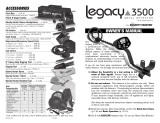
CHARGING BATTERIES
A battery charge socket is provided for use with the C-Scope battery charger (see Accessories)
and is located under the protective cap in the battery housing. (The smaller of the two sockets.)
Inserting the charger will automatically remove the power from the detector so the charger must
be removed to do a battery check. Do not attempt to recharge standard batteries. It will take
between eight and fifteen hours to fully recharge flat batteries with the C-Scope charging unit.
For further information, and a price list, for all C-Scope accessories please telephone
(01233) 629181, or contact your local dealer.
THE IMPORTANCE OF THE RIGHT APPROACH
Treasure hunting can be a profitable and rewarding hobby, if approached in a patient and diligent
manner. Time spent researching to locate a worthwhile site for a search can be time wasted if
your search is hasty and erratic. To achieve maximum results it is important then, to decide on
your approach to any particular site in advance of the actual search.
Tactics will be decided by the type of site - it is more profitable to scan a small area thoroughly
than to conduct a haphazard search of the total site. However, when the site is too far away for
you to make several return visits, a plan should be adopted which gives maximum coverage, at
the same time as indicating the most likely area for detailed search.
Your detector alone is not a guarantee of successful treasure hunting. Any detector needs an
operator and for the best results the operator needs the right approach, attitude and technique.
Too many beginners neglect the importance of pre-planning and research before using their
detector in the field, and patience and technique during the actual search.
A successful search should begin with research some time before the day of the actual search.
The extent and thoroughness of your research will be one of the major factors in the success of
your detecting. You should aim to get as complete an understanding as possible of the local
history and geography.
The key to the choice of site is to think of people, where they congregated over the past few
hundred years. What were their customs and pursuits? Where did they spend money? Where did
they carry money? The answers are not Roman sites, nor are they associated with mystic treasure
stories of crocks of gold. Rather, they are unassuming, undramatic places, like public footpaths
and ancient rights of way, old houses and so on.
When you have chosen your site, allocate a whole day from early morning to early evening for
the search. Make sure you have all the equipment you are likely to need. Your detector should be
checked before starting out, and you should always carry a spare set of batteries. You will also
need a strong, sharp trowel. It is also a good idea to have a set of lines and pins so that you can
lay out your search area scientifically.
Most beginners make the mistake of rushing about hoping to chance upon a rare find. If for
example there happened to be a valuable ring that was buried 4" deep on the site you were
searching, if you rushed about haphazardly and quickly on the site, the odds would be very much
16

































